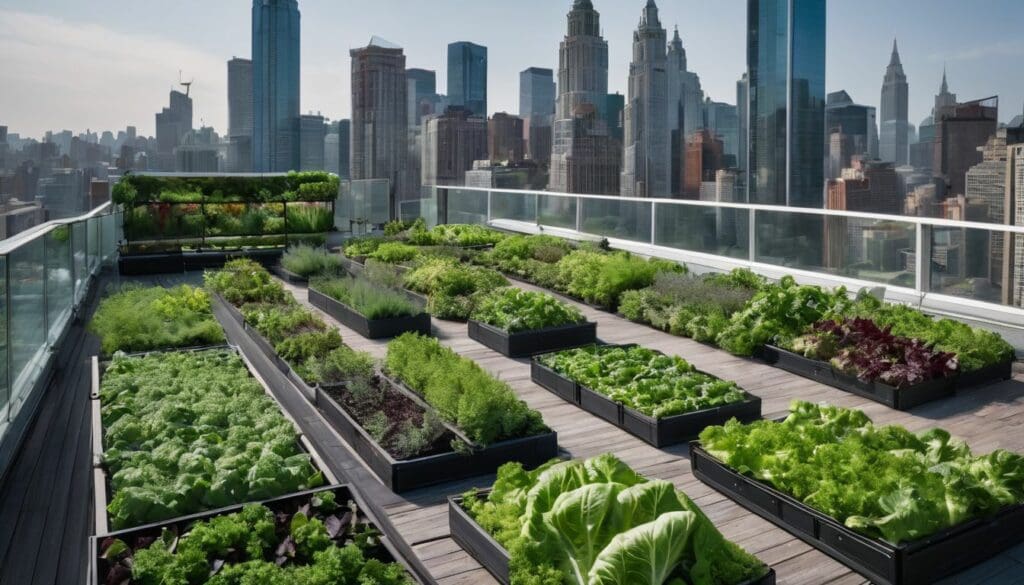Traditional food production methods have a significant impact on the environment and urban areas. However, advancements in urban agriculture have provided sustainable solutions for feeding cities.
To find out more about how urban farming is shaping the future of sustainable cities, keep reading!
Impact of traditional food production methods
Traditional food production methods often involve extensive land use, water consumption, and reliance on chemical fertilisers and pesticides. These methods contribute to deforestation, soil degradation, and water pollution.
In addition, transportation of produce from rural areas to cities contributes to greenhouse gas emissions. The current system is not sustainable in the long term due to its heavy environmental impact and limited resource availability.
Urban agriculture offers an alternative by repurposing underutilised urban spaces for food production. This reduces the need for long-distance transportation while promoting local food resilience.
Advancements in urban agriculture
Transforming urban landscapes, advancements in urban agriculture are revolutionising how cities produce food sustainably. Vertical farming and green roofs are leading the way in this movement, repurposing underutilised city spaces into flourishing gardens.
Technological innovations have allowed for the creation of vertical farms that use hydroponic and aeroponic systems to grow crops upwards instead of outwards. Additionally, green roofs have been developed to utilise rooftop space for agricultural purposes, reducing the urban heat island effect and providing biodiversity in densely populated areas.
Urban horticulture has further advanced with the integration of nature-based solutions such as green roofs and vertical gardens. These eco-friendly initiatives not only address food scarcity but also contribute to sustainable urban development by mitigating stormwater runoff and enhancing biodiversity within cities.
Green Roofs: Harnessing Nature’s Power
Green roofs provide numerous benefits to urban areas, such as reducing energy usage, improving air quality, and mitigating stormwater runoff. To learn more about how green roofs are revolutionising sustainable cities, keep reading!
Benefits of green roofs
Green roofs offer numerous benefits to urban environments, including:
- Increased biodiversity, as they provide habitats for birds, insects, and other wildlife.
- Improved health and well – being for city residents through access to green spaces and cleaner air.
- Urban agriculture opportunities, contributing to local food production and reducing the carbon footprint of food transportation.
- Educational opportunities for schools and community groups to learn about sustainable agriculture and ecology.
- Nature – based solutions for improving urban environments and promoting sustainability.
- Reduction of surface temperatures of buildings and the surrounding area, enhancing urban heat island mitigation efforts.
- Enhancement of building energy efficiency by providing natural insulation and reducing the need for heating and cooling systems.
Engineering and design considerations
When implementing green roofs and vertical farms in urban areas, careful engineering and design considerations play a crucial role. The structural integrity of buildings needs to be carefully assessed to ensure they can support the additional weight of soil, plants, and water systems for green roofs.
Similarly, for vertical farming, the design must account for efficient use of space and lighting systems that promote plant growth without excessive energy consumption. Additionally, irrigation systems need to be meticulously planned to minimise water usage while maximising crop yield.
Innovative engineering solutions are vital for creating sustainable urban agricultural spaces that not only enhance biodiversity but also contribute towards reducing energy consumption and mitigating environmental impact.
Properly designed green roofs and vertical farms can transform urban landscapes into thriving ecosystems that provide food security and contribute to a more sustainable future.
Vertical Farming: Growing Up Instead of Out
Vertical farming offers a more sustainable solution to food production in urban areas, taking advantage of advanced technology and innovative growing methods. To learn more about the benefits and advancements in vertical farming, keep reading!
Advantages of vertical farming
- Maximising land use: Vertical farms utilise vertical space, allowing for higher crop yields in a smaller footprint.
- Reduced transportation emissions: By growing food closer to urban centres, vertical farming minimises the need for long-haul transportation and associated emissions.
- Conserving water: Vertical farming systems often employ hydroponics or aeroponics, which use significantly less water compared to traditional soil-based agriculture.
- Year-round production: Controlled indoor environments in vertical farms enable year-round cultivation, reducing seasonal limitations and increasing overall productivity.
- Efficient resource utilisation: Vertical farms can optimise energy use, minimise pesticide and herbicide usage, and reduce food waste through precise control of growing conditions.
Technological innovations
Technological innovations in urban farming have revolutionised the way we grow food in cities. Cutting-edge methods like hydroponics and aquaponics enable efficient crop production without soil, conserving water and space.
These advanced techniques also incorporate automation and data analysis to optimise growing conditions, ensuring maximum yield with minimal environmental impact. Additionally, advancements in LED lighting technology have made it possible to cultivate crops indoors throughout the year, further enhancing the sustainability of urban farming.
In conjunction with technological advancements, vertical farming systems utilise space-saving designs that stack crops vertically, maximising productivity within limited city areas.
This approach significantly reduces land use while increasing food production capacity in densely populated urban environments. Moreover, innovative irrigation systems allow precise control over water usage and nutrient delivery, contributing to resource efficiency and sustainable agricultural practices.
Overcoming Challenges for a Sustainable Future
Addressing food security and social impact is crucial for the long-term sustainability of urban farming, while also tackling environmental issues to create a greener and healthier future for cities.
To learn more about how sustainable cities are evolving with innovative solutions like green roofs and vertical farms, keep reading!
Addressing food security and social impact
To tackle food security and promote social impact in urban areas, urban farming plays a crucial role. By repurposing underutilised city spaces into sustainable food sources, urban agriculture addresses the challenge of resource scarcity while contributing to climate change mitigation efforts.
Green roofs and vertical farms not only provide fresh produce but also create opportunities for community engagement and education about sustainable living practices. These innovative solutions are essential in creating more eco-friendly cities that prioritise sustainability and resilience in the face of environmental challenges.
Urban horticulture, such as green roofs and vertical farming, actively contributes to reducing the urban heat island effect, mitigating stormwater runoff, promoting biodiversity, and improving residents’ health and well-being.
Tackling environmental issues
– Addressing food security and social impact has been a crucial step towards creating sustainable cities. Now, tackling environmental issues is equally important for ensuring the long-term health and resilience of urban areas.
Urban agriculture, including green roofs and vertical gardens, not only provides fresh produce but also helps in mitigating climate change by reducing the urban heat island effect and stormwater runoff.
These nature-based solutions contribute to enhancing urban biodiversity while improving the overall environmental quality within cities.
– Green roofs serve as a powerful tool for addressing environmental concerns in urban areas. With their ability to reduce surface temperatures of buildings and improve energy efficiency, they play a pivotal role in promoting eco-friendly cities.
Inspiring Examples of Urban Farming Around the World
We showcase outstanding urban farming initiatives from different corners of the globe, such as Sky Greens in Singapore and Brooklyn Grange in New York. Read on to discover how these innovative projects are leading the way towards sustainable urban living.
Sky Greens, Singapore
Sky Greens, located in Singapore, is a pioneering example of vertical farming in urban settings. The country has repurposed its limited land space to transform rooftops into productive gardens, utilising innovative technology to grow fresh produce for its residents.
Through this sustainable approach, Sky Greens helps address food security and environmental challenges faced by the densely populated city-state. By embracing nature-based solutions such as vertical farms, Singapore sets an inspiring example for other cities aiming to achieve urban sustainability.
Moving on from Sky Greens’ success story, let’s explore another remarkable initiative making waves in the sustainable cities movement – Brooklyn Grange in New York, USA.
Brooklyn Grange, New York, USA
Located in the bustling city of New York, Brooklyn Grange is an impressive example of urban agriculture. This rooftop farm covers over two and a half acres and produces an abundance of fresh vegetables for local communities using eco-friendly methods.
The farm not only provides sustainable, locally grown produce but also offers educational opportunities, workshops, and community events to promote environmental awareness and healthy living.
Through their innovative approach to urban farming, Brooklyn Grange is contributing to the movement towards more sustainable cities while fostering a sense of community engagement.
City Farm, Sydney, Australia
Following the innovative urban farming project at Brooklyn Grange, New York, USA, let’s turn our attention to City Farm in Sydney, Australia. This urban horticulture initiative is contributing to the city’s eco-friendly landscape by repurposing unused spaces into sustainable food sources.
Situated in the heart of the bustling metropolis, City Farm embodies green urbanism through its nature-based solutions and commitment to sustainability. With a focus on urban agriculture and community engagement, this project is paving the way for a more sustainable future by addressing food security and social impact while tackling environmental issues.
The integration of such initiatives not only adds an element of natural beauty but also serves as an educational opportunity for residents to learn about sustainable living practices.
Conclusion
In conclusion, urban farming is rapidly shaping sustainable cities by repurposing city spaces for productive agriculture. Green roofs and vertical farms are transforming rooftops into eco-friendly gardens, reducing the urban heat island effect and improving biodiversity.
These nature-based solutions play a pivotal role in the movement towards sustainable cities and contribute to addressing climate change and resource scarcity. Singapore’s successful implementation of vertical farming serves as an inspiring example of urban innovation paving the way for self-sufficient ecosystems.
FAQs
1. What does it mean for a city to be sustainable?
A sustainable city focuses on eco-friendly practices, like setting up green roofs and vertical farms, to support the environment while looking after urban needs.
2. How do green roofs help cities become more sustainable?
Green roofs cover building tops with plants, which can lower heating costs, absorb rainwater, and provide wildlife habitats in busy cities.
3. Can you grow food in a city using vertical farming?
Yes! Vertical farms stack plant beds upwards instead of spreading them outwards, so you can grow lots of food even in small urban spaces.
4. Why is it important for cities to use nature-based solutions?
Nature-based solutions bring natural elements into cities; they help clean the air, reduce flood risks and make urban areas nicer places to live.





